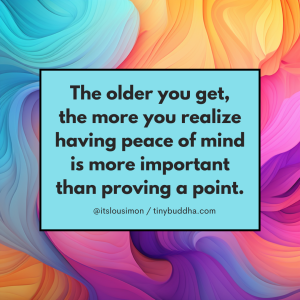
“If we can share our story with someone who responds with empathy and understanding, shame can’t survive.” ~Brené Brown
Every time I think I’ve unloaded most of the pain from my past, something surfaces that tells me I have more work to do.
A couple of weeks ago, my boyfriend and I were cuddling one morning. I’m not sure what the trigger was, but out of nowhere, my thoughts rolled down a hill and into a painful memory that I must have blocked out.
Tears rolled down my cheeks as my whole body curled up into the fetal position. He asked me what was wrong and I slowly told him about a sexual trauma I had experienced.
We are radically honest with one another. Sharing the not so beautiful has deepened our connection. I thought I had shared my darkest secrets that carry shame.
I was wrong.
I had minimized and buried this story. Maybe subconsciously, I was afraid he would see this situation as my fault. He absolutely didn’t, and sharing my experience with him made me feel like a heavy burden was lifted.
This last part rang especially true the following week when the #metoo hashtag went viral. It was during that week of teasing through my feelings and thoughts that I realized just how much confusion shame can create.
The word shame can evoke such discomfort that we often don’t see how it shows up in our lives.
If there’s one emotion I see as most prevalent and most hidden in the work I do, it’s shame. Every time I lead a workshop or retreat, there’s a common theme that I witness in nearly everyone. As humans, we all tend to feel in some way that we’re unworthy.
Yet, the last thing we want to do is acknowledge our shame and vulnerability.
But if left buried, shame inevitably causes harm to ourselves and our relationships. In my experience, I’ve seen firsthand how understanding and shedding light on shame can hold the key to healing.
Shame is the emotion that says, “I am bad. I am unworthy.”
It’s not that we did something bad and feel remorseful. That’s guilt. Guilt says, “I did something bad.” But shame is the internalization of “I am bad.”
Most of us, even if we had kind, loving parents, grew up feeling a bit like we had to censor our true feelings and experiences. We may have done this to avoid dismay, protect others, or keep the peace in our families.
We’re conditioned from a young age to feel shame when we learn who we shouldn’t be in the world. But as we get older, we don’t need others to make us feel shame. Shame becomes easily internalized and lives in that voice that says, “It’s dangerous to let others hear my story,” or, “They won’t love me if I share this secret.”
Who we are becomes fragmented so that we hide the parts of ourselves we want no one to see. We unconsciously employ defense mechanisms. While those defense mechanisms might help us to survive, they’re bound to stand in the way of having healthy relationships and growing a sense of self-love.
When we’re afraid to share our vulnerable side because we believe it would render us flawed, dirty, weak, and so forth, we’re carrying shame.
Shame is carried silently and secretly for fear of judgment; yet, it is the self-judgment that grows the longer we conceal our vulnerability.
I refuse to keep painful secrets festering inside of me, as I know that will only keep me repressed and disempowered in the long run.
All humans experience shame, and it presents in many ways. Here are a few examples I’ve noticed within myself that maybe you can relate to:
- Being too sensitive and emotional
- Not doing enough to “save” my mother from her death
- Being too selfish to fully want to be a mother myself
- Feeling I’m not ambitious or smart enough to live up to my potential
- Struggling to communicate clearly when I have too much in my head
- Feeling too “needy” with my partner at times
- Believing I was somehow at fault for the sexual abuses I have experienced
My personal list could go on… But what I noticed when writing this list is that while many of the original sources of shame might be specific people or society as a whole, the critic is still me.
When we keep shame locked away inside, we get stuck in feelings of inadequacy. Shame may cause us to feel mentally or physically ill. Feelings of inadequacy can be accompanied by emotions such as anxiety, anger, and loneliness. And when we feel inadequate, we sometimes develop destructive ways of relating to others: avoidance, lying, blaming others, attempts to control others, and so forth.
So how can we deal with this lurking self-critic that wants to keep our stories in the dark?
1. Speak kindly to yourself.
Most likely, at some point you’ve heard the phrase, “Shame on you,” or, “You should be ashamed.” It can easily become habit to talk similarly to ourselves and challenging to learn to speak kindly.
A simple framework for healing I teach comes from an ancient Hawaiian tradition called H’oponopono. H’oponopono means “to make right,” and it’s rooted in the essence of reconciliation and compassion.
H’oponopono consists of four phrases: I’m sorry. I forgive you. Thank you. I love you. You can use these phrases speaking to another person. And you can use them with yourself. Here’s a personal example of the latter:
Melissa, I’m sorry for making you feel the trauma you experienced was your fault.
Melissa, I forgive you for placing blame on yourself and carrying shame all these years.
Melissa, thank you for your courage to shine light on your vulnerability and resilience.
Melissa, I love you and I commit to treating you with lovingkindness.
2. Self-soothe with movement and massage.
Think about what happens to your body when you recall a memory that carries shame. Often our bodies slump sinking our heart into the back body. Our gaze drops and our brows furrow.
Emotions, including shame, reside in the body. Much of what I practice and teach relates to physical ways to release stuck emotion for this reason.
If we want to reduce the unworthy and unlovable feelings we carry, it can help to self-soothe your body through dynamic movement practices like yoga and dance. Self-massage, tapping, and comforting touch while speaking kindly to yourself can help to release shame.
3. Share your story.
The most uncomfortable, but perhaps most effective method I can offer you is to share.
You don’t have to share your vulnerability with the whole world. Many of my friends shared courageous, deeply personal stories on Facebook in response to #metoo. For a moment, I thought I had to share this way as well, but then I did some reflection.
There are times I share my vulnerability through my blog or when I hold space for a group. But I don’t always want to share everything with strangers. In those cases, my partner is my greatest witness because of his ability to hold space for me.
Whether you share in a twelve-step program, with a loved one, or therapist, or in an article for the world to see, there’s immense healing power in this process. When our voices are heard and we’re seen just as we are, we open up the door to growing a new sense of self-love and self-worth.
About Melissa Renzi
Melissa Renzi is a Licensed Social Worker and Certified Trauma-Informed Yoga Teacher. She helps sensitive souls transform anxiety and cultivate lasting self-love. She leads global retreats designed for women, introverts, and highly sensitive people that focus on renewing self-care and deepening our connection to the natural world. Access her Highly Sensitive Person’s Relationship Guide for concrete tools to create intimate, fulfilling relationships.
- Web |
- More Posts













 Though I run this site, it is not mine. It's ours. It's not about me. It's about us. Your stories and your wisdom are just as meaningful as mine.
Though I run this site, it is not mine. It's ours. It's not about me. It's about us. Your stories and your wisdom are just as meaningful as mine. 